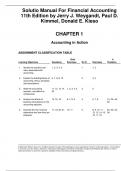Exam (elaborations)
Solution Manual For Financial Accounting 11th Edition by Jerry J. Weygandt, Paul D. Kimmel, Donald E. Kieso / Latest & Updated Version 2024 A+
- Module
- Institution
- Book
Solution Manual For Financial Accounting 11th Edition by Jerry J. Weygandt, Paul D. Kimmel, Donald E. Kieso / Latest & Updated Version 2024 A+ Solutio Manual For Financial Accounting 11th Edition by Jerry J. Weygandt, Paul D. Kimmel, Donald E. Kieso CHAPTER 1 Accounting in Action ASSIGNMENT C...
[Show more]



